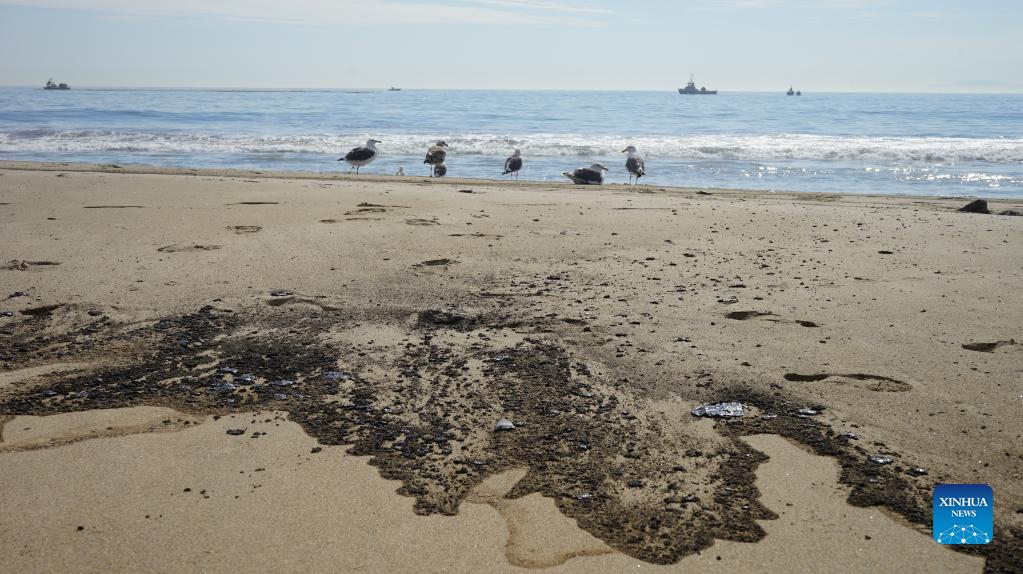
Oil stains the Huntington Beach in Orange County, California
LOS ANGELES, Oct 4 (NNN-Xinhua) — A massive oil spill off the Orange County coast in Southern California prompted the closure of a 9-kilometer long beachfront area on Sunday, and crews from California Department of Fish and Wildlife (CDFW) are cleaning up the pollution from facilities in federal waters.
Orange County Supervisor Katrina Foley told local KTLA news channel Sunday morning that the incident was first reported Saturday and oil was still leaking about about 8.05 kilometers off the coast of Huntington Beach from the broken pipeline.
“It’s still leaking and the responsible party for this is underway right now trying to repair the leak from the pipeline,” Foley said, referring to the platform Elly, a facility sitting in federal waters off the Los Angeles County coast and processing crude oil production from two other platforms.
All these platforms are located on top of a large reservoir of crude oil known as the Beta Field, which sits in waters overseen by the U.S. Department of the Interior.
The spill, equal to about 126,000 gallons of post-production crude, is a “potential ecological disaster,” Huntington Beach Mayor Kim Carr said.
The United States Coast Guard (USCG) said in a statement that a unified command, consisting of Beta Offshore, the Coast Guard, and Spill Prevention and Response (OSPR) from CDFW, had been established to respond to the incident.
“Members of the public are asked to avoid any oiled areas. Trained spill response contractors are working to clean up oil. Public volunteers are not needed and could hinder response efforts. We request that members of the public stay away from the area.” the statement said, adding that the cause of the spill, volume and type of oil are under investigation.
The oil slick was “reported to be approximately 33.7 square kilometers in size, about 4.82 kilometers off Newport Beach.” the USCG said in an earlier twitter.
Local authorities urged people to avoid the beach areas around Huntington Beach and Newport Beach, saying “the spill has significantly affected Huntington Beach, with substantial ecological impacts occurring at the beach and at the Huntington Beach Wetlands.”
By Sunday morning, “we’ve started to find dead birds & fish washing up on the shore,” Foley tweeted.
Debbie McGuire, executive director of the Wetlands and Wildlife Care Center in Huntington Beach, was quoted by the local newspaper Orange County Register that staff in the center had prepared masks, goggles and IV fluids to stabilize the animals injured by the pollution.
McGuire said the first batch of wounded birds were sent to the center Sunday noon, including three pelicans, a ruddy duck and a surf scoter.
The oil spill also prompted the cancelation of the final day of the Great Pacific Airshow. The 5th annual air show began Friday morning at the Huntington Beach Pier and drew about 1.5 million visitors to the beach on Saturday. The event was scheduled to run through Sunday afternoon.
The last major oil spill hit the Southern California area was 30 years ago. In 1990, the American Trader oil tanker spilled 417,000 gallons of crude, killing fish and approximately 3,400 birds and polluting popular beaches along the Orange County coast.
California has been taking a tough stand to protect its coast from the offshore oil and gas development since 1994 when the state legislature passed the California Coastal Sanctuary Act. It prohibits the state from entering into any new leases within state tidelands.
In 2017, the California Senate passed a resolution opposing new oil or gas drilling in federal waters located offshore California.
In 2019, when the Donald Trump administration planned to lease sales along the country’s coast and vastly expand offshore oil drilling from coast to coast, the Golden State passed a law prohibiting new leases for new construction of oil and gas-related infrastructure, such as pipelines, within state waters if the federal government authorizes any new offshore oil leases. — NNN-XINHUA




